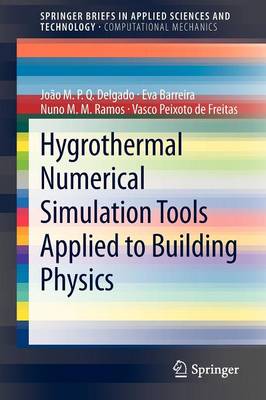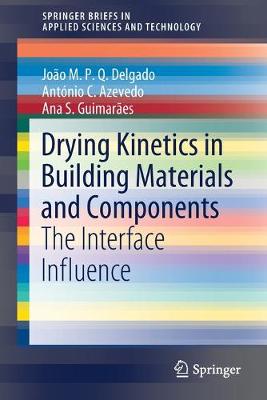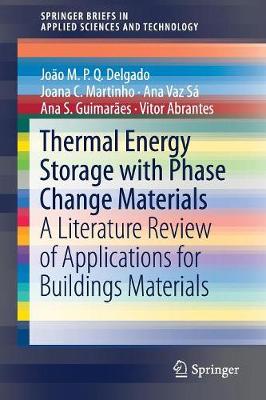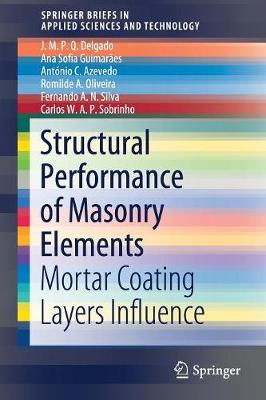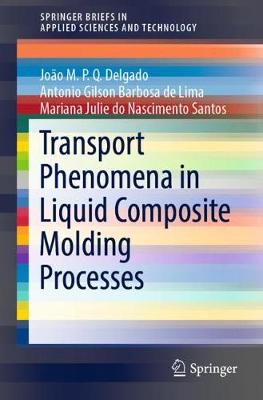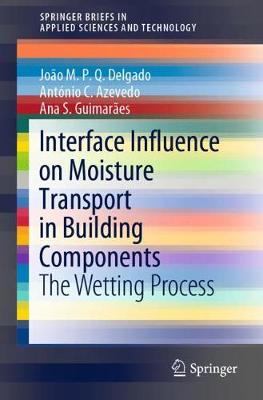SpringerBriefs in Applied Sciences and Technology
8 total works
Hygrothermal Numerical Simulation Tools Applied to Building Physics
by Joao M.P.Q. Delgado, Eva Barreira, Nuno M.M. Ramos, and Vasco Peixoto de Freitas
During the past few decades there has been relevant development in this field of study and an increase in the professional use of tools that simulate some of the physical phenomena that are involved in Heat, Air and Moisture conditions in building components or elements. Although there is a significant amount of hygrothermal models referred in the literature, the vast majority of them are not easily available to the public outside the institutions where they were developed, which restricts the analysis of this book to only 14 hygrothermal modelling tools.
The special features of this book are (a) a state-of-the-art of numerical simulation tools applied to building physics, (b) the boundary conditions importance, (c) the material properties, namely, experimental methods for the measurement of relevant transport properties, and (d) the numerical investigation and application
The main benefit of the book is that it discusses all the topics related to numerical simulation tools in building components (including state-of-the-art and applications) and presents some of the most important theoretical and numerical developments in building physics, providing a self-contained major reference that is appealing to both the scientists and the engineers. At the same time, this book will be going to the encounter of a variety of scientific and engineering disciplines, such as civil and mechanical engineering, architecture, etc… The book is divided in several chapters that intend to be a resume of the current state of knowledge for benefit of professional colleagues.
Drying Kinetics in Building Materials and Components
by Joao M. P. Q. Delgado, Antonio C. Azevedo, and Ana S. Guimaraes
Salt Damage in Ceramic Brick Masonry
by Joao M.P.Q. Delgado, Fernando A.N. Silva, Antonio C. Azevedo, and Ariosvaldo Ribeiro
This book discusses the effects of soluble mineral salts on ceramic brick masonry walls in Petrolina, a city in Pernambuco, Brazil, located 780 km from the ocean. To shed light on this phenomenon, the authors mapped the pathologies originating from the effects of soluble mineral salts and installed wells to monitor the underground water supply at five locations in the city where the phenomenon most frequently occurs. Further, they analyzed samples of soil, groundwater, and bricks affected by the phenomenon and measured levels of chloride in the atmosphere at these sites. The results obtained indicate that the pathological manifestations are influenced by the high levels of soluble salts observed in the soil and groundwater samples collected, and are not affected by chloride in the atmosphere.
Thermal Energy Storage with Phase Change Materials
by Joao M.P.Q. Delgado, Joana C. Martinho, Ana Vaz Sa, Ana S. Guimaraes, and Vitor Abrantes
This short book provides an update on various methods for incorporating phase changing materials (PCMs) into building structures. It discusses previous research into optimizing the integration of PCMs into surrounding walls (gypsum board and interior plaster products), trombe walls, ceramic floor tiles, concrete elements (walls and pavements), windows, concrete and brick masonry, underfloor heating, ceilings, thermal insulation and furniture an indoor appliances.
Based on the phase change state, PCMs fall into three groups: solid-solid PCMs, solid-liquid PCMs and liquid-gas PCMs. Of these the solid-liquid PCMs, which include organic PCMs, inorganic PCMs and eutectics, are suitable for thermal energy storage.
The process of selecting an appropriate PCM is extremely complex, but crucial for thermal energy storage. The potential PCM should have a suitable melting temperature, and the desirable heat of fusion and thermal conductivity specified by the practical application. Thus, the methods of measuring the thermal properties of PCMs are key.
With suitable PCMs and the correct incorporation method, latent heat thermal energy storage (LHTES) can be economically efficient for heating and cooling buildings. However, several problems need to be tackled before LHTES can reliably and practically be applied.
Structural Performance of Masonry Elements
by J M P Q Delgado, Ana Sofia Guimaraes, Antonio C. Azevedo, Romilde A. Oliveira, Fernando A.N. Silva, and Carlos W.A.P. Sobrinho
This book discusses the main mechanical features of masonry buildings and the peculiarities that affect their structural behaviour. It also examines technical information regarding accidents that have occurred in recent years in the Metropolitan Region of Recife, along with the historical records of these events, followed by indications of the causes for the collapse.
The book offers extensive experimental results that make it possible to identify the contribution of several mortar rendering layers to the load capacity of the tested specimens. Lastly, it explores the factors that influenced the load capacity of the tested specimens.
Transport Phenomena in Liquid Composite Molding Processes
by Joao M.P.Q. Delgado, Antonio Gilson Barbosa de Lima, and Mariana Julie do Nascimento Santos
This book provides valuable information on polymer composite manufacturing, with a focus on liquid molding processes and the resin transfer molding technique (RTM). It presents and discusses emerging topics related to the foundations, engineering applications, advanced modeling and experiments regarding the RTM process. A valuable resource for engineers, professionals in industry and academics involved in this advanced interdisciplinary field, it also serves as a comprehensive reference book for undergraduate and postgraduate courses.
Intelligent Residential Buildings and the Behaviour of the Occupants
by Pedro F. Pereira, Nuno M. M. Ramos, and Joao M. P. Q. Delgado
This book presents the state of the art of two areas: intelligent residential buildings and the behaviour of their occupants. These areas need to be treated together in order to develop new concepts for buildings, which are more efficient, more comfortable and more healthy.
The concept of intelligent building is associated with the creation of a management system that takes into account the requirements of the occupants in terms of thermal comfort and their daily activities, maintaining good indoor air quality and minimizing energy consumption. In commercial or office buildings, these systems are already at an intermediate stage of implementation. However, in the residential sector they have yet to be significantly implemented. In mild climates, where the interactions of the occupants with the building mechanisms are the primary way to ensure adequate comfort and ventilation, the importance of occupant behaviour studies and their incorporation in the algorithms of the intelligent buildings becomes even more crucial.
This book offers new concepts on how to bring these aspects together.
Interface Influence on Moisture Transport in Building Components
by Joao M. P. Q. Delgado, Antonio C. Azevedo, and Ana S. Guimaraes
The knowledge of moisture migration inside building materials and construction building components is decisive for the way they behave when in use. The durability, waterproofing, degrading aspect and thermal behaviour of these materials are strongly influenced by the existence of moisture within their interior, which provoke changes in their normal performance, something that is normally hard to predict. Due to the awareness of this problem, the scientific community have per-formed various studies about the existence of moisture inside porous materials. The complex aspects of moisture migration phenomenon tended to encompass monolithic building elements, since the existence of joints or layers contributes to the change of moisture transfer along the respective building element that contribute to the change of mass transfer law. The presentation of an experimental analyses concerning moisture transfer in the interface of material that makes up masonry is described in such a way as to evaluate the durability and/or avoid building damages.
In this work it was analysed, during the wetting process, the influence of different types of interface, commonly observed in masonry, such as: perfect con-tact, joints of cement mortar, lime mortar, and the air space interface. The results allow the calculation of the hygric resistance. With these results, it is possible to use any advanced hygrothermal simulation program to study the water transport in building elements, considering different interfaces and their hygric resistance.
